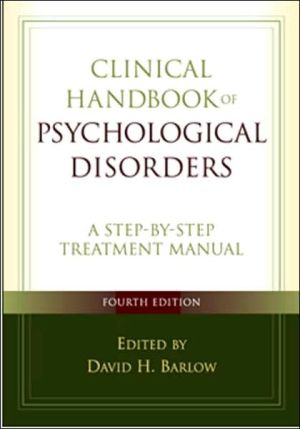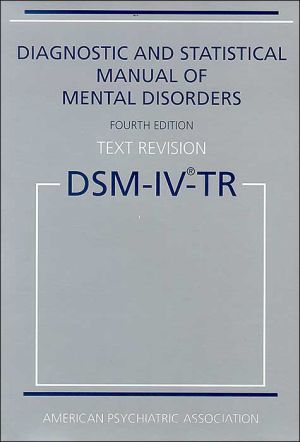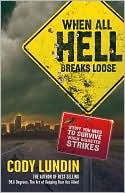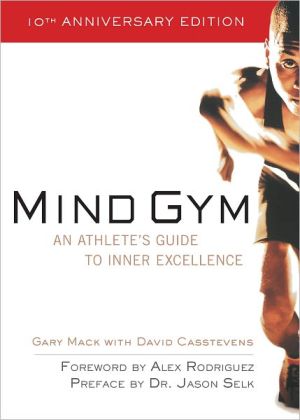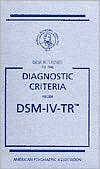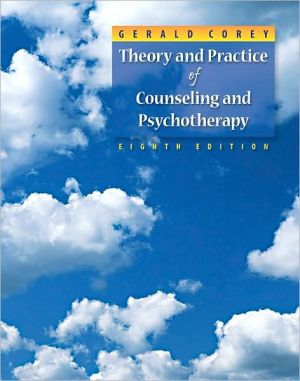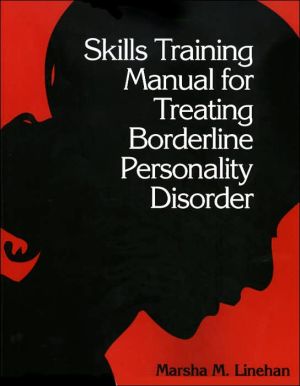Clinical Handbook of Psychological Disorders: A Step-by-Step Treatment Manual
The first edition of this widely adopted, classic bestseller, published in 1985, represented a distinct departure from other available handbooks. Eschewing a cursory review of therapeutic procedures, it presented in unprecedented detail the actual protocols used to assess and treat frequently encountered psychological disorders. Now, this updated and expanded second edition, the first volume to be totally organized around proposed DSM-IV criteria, incorporates the numerous advances that have...
Search in google:
With over 75,000 copies sold, this clinical guide and widely adopted text presents state-of-the-science guidelines for treating frequently encountered adult disorders. The Handbook is unique in its focus on evidence-based practice and its attention to the most pressing question asked by students and practitioners--"How do I do it?" Leading clinical researchers provide essential background knowledge on each problem, describe the conceptual and empirical bases of their respective approaches, and illustrate the nuts and bolts of evidence-based assessment and intervention. The fourth edition is thoroughly revised and expanded to include the latest treatment innovations and empirical findings. New chapter topics include behavioral activation for depression, psychological treatments for positive symptoms of schizophrenia, and unified approaches to emotional disorders and eating disorders. American Journal of Psychiatry An extremely helpful and user-friendly addition to the clinician's reference library....Offers an immense amount of information about effective treatments that can be applied by the beginning clinician and the seasoned therapist.
1. Panic Disorder and Agoraphobia, Michelle G. Craske and David H. Barlow\ 2. Posttraumatic Stress Disorder, Patricia A. Resick and Karen S. Calhoun\ 3. Social Anxiety Disorder, Cynthia L. Turk, Richard G. Heimberg, and Debra A. Hope\ 4. Generalized Anxiety Disorder, Timothy A. Brown, Tracy A. O'Leary, and David H. Barlow\ 5. Obsessive-Compulsive Disorder, Edna B. Foa and Martin E. Franklin\ 6. Cognitive Therapy for Depression, Jeffrey E. Young, Arthur D. Weinberger, and Aaron T. Beck\ 7. Interpersonal Psychotherapy, Laura Gillies\ 8. Eating Disorders, G. Terence Wilson and Kathleen M. Pike\ 9. Alcohol Use Disorders, Barbara S. McCrady\ 10. Cocaine Dependence, Stephen T. Higgins, Alan J. Budney, and Stacey C. Sigmon\ 11. Dialectical Behavior Therapy for Borderline Personality Disorder, Marsha M. Linehan, Bryan N. Cochran, and Constance A. Kehrer\ 12. Bipolar Disorder, David J. Miklowitz\ 13. Sexual Dysfunction, Amy K. Bach, John P. Wincze, and David H. Barlow\ 14. Couple Distress, Jennifer G. Wheeler, Andrew Christensen, and Neil S. Jacobson
Ch. 1Panic Disorder and Agoraphobia1Ch. 2Posttraumatic Stress Disorder60Ch. 3Social Anxiety Disorder114Ch. 4Generalized Anxiety Disorder154Ch. 5Obsessive-Compulsive Disorder209Ch. 6Cognitive Therapy for Depression264Ch. 7Interpersonal Psychotherapy for Depression and Other Disorders309Ch. 8Eating Disorders332Ch. 9Alcohol Use Disorders376Ch. 10Cocaine Dependence434Ch. 11Dialectical Behavior Therapy for Borderline Personality Disorder470Ch. 12Bipolar Disorder523Ch. 13Sexual Dysfunction562Ch. 14Couple Distress609Author Index631Subject Index651
\ From The CriticsReviewer: Christopher J. Graver, PhD, ABPP-CN(Madigan Healthcare System)\ Description: Evidence-based practice is becoming the norm in psychology with the growing scientific knowledge and expectations from managed care organizations. This book covers the major empirically supported treatments (ESTs) and their use in a variety of disorders. \ Purpose: The main purpose is to provide a step-by-step guide to ESTs. This differs from other books in that it is an explicit guide, rather than just a review of the literature.\ Audience: The book is intended for psychologists, psychiatrists, and other therapists. Students of these disciplines will find it especially helpful as they attempt to figure out how to apply these treatments in a clinical setting. The editor is accomplished in the field and has gathered an A-list of contributors, including Tim Beck, Marsha Linehan, and Michelle Craske.\ Features: What is immediately noticeable is that there is no wasted space in this book. The first chapter begins with treatments for panic disorder and the coverage of disorders and treatments never ceases through 16 chapters. These include panic disorder, social phobia, OCD, PTSD, depression, bipolar disorder, schizophrenia, borderline personality disorder, substance abuse, eating disorders, sexual dysfunction, and couple distress. Although the structure of each chapter may differ somewhat, all generally contain an introduction to the disorder, including epidemiology, presenting features and diagnosis, initial assessment, and an overview of treatments and their efficacy. The latter part of each chapter consists of case examples that step through the treatment. Each session is discussed and sample dialogue is provided. In some chapters there are samples of assessment instruments, worksheets, and other tools used in session, and materials for the patient. For readers new to these treatments, information about the model and theoretical underpinnings is included. The chapter on PTSD has been expanded with a recent case from Iraq. Additionally, the substance abuse chapter has expanded to broadly cover multiple substances. A new chapter on behavioral activation in depression has been added, which is especially pertinent given other recent publications on behavioral treatments for depression. The numerous references provide starting points for even greater refinement of these techniques. The index is quite detailed and lengthy.\ Assessment: This is an exceptional book for both the literature reviews of ESTs and the hands-on descriptions of these treatments. It will undoubtedly aid in the delivery of psychological treatment. In a body of literature replete with general comparisons, reviews, and meta-analyses, this book stands out as a truly practical step-by-step guide to the major psychological treatments currently available. Students of psychology, psychiatry, and related fields should embrace this in their training.\ \ \ \ \ Journal of Clinical Psychiatry"This book continues the tradition of previous editions by offering some of the most widely used treatment approaches, described in great detail by the developers of the protocols....How can we provide patients suffering from various mental health problems with the most rigorously studied, efficient, and effective treatments? How do we best offer trainees in psychology, psychiatry, and other disciplines, as well as experienced clinicians, direction in the application of such approaches? This book proffers an excellent answer to both questions."--Journal of Clinical Psychiatry\ \ \ From the Publisher"This is an exceptional book for both the literature reviews of empirically supported treatments and the hands-on descriptions of these treatments. It will undoubtedly aid in the delivery of psychological treatment. In a body of literature replete with general comparisons, reviews, and meta-analyses, this book stands out as a truly practical step-by-step guide to the major psychological treatments currently available. Students of psychology, psychiatry, and related fields should embrace this in their training....5 stars!"--Doody's Review Service\ "This is the best single-volume presentation of the state of the art for psychologists, social workers, and other mental health professionals working with people suffering from common mental disorders. Each up-to-date chapter provides a comprehensive review of assessment and therapy methods. This fourth edition will be an indispensable resource for clinicians for years to come."--Michael E. Thase, MD, Department of Psychiatry, University of Pittsburgh Medical Center and Western Psychiatric Institute and Clinic\ "An outstanding resource. Each chapter presents a creative blend of theory, research, and practice, offering unique insights into the latest developments in evidence-based treatment. Barlow has assembled some of the most important authorities on psychosocial interventions to provide a comprehensive understanding of effective clinical practice. Our Counseling Psychology program has used the previous editions of this book in counseling practica and advanced intervention courses, and students were overjoyed to find a book that helped them make the transition from the classroom to the clinic. I have told psychology graduate students and psychiatry residents that if they could buy only one book on psychotherapy, this would be the one to buy."--Leonard A. Doerfler, PhD, Professor and Director, Counseling Psychology Program, Assumption College\ "This latest edition of a classic continues the excellence of prior editions. Leading scientistclinicians review the best theory and research on the nature and treatment of a broad range of psychological disorders, providing an essential guide for students, faculty, and experienced practitioners alike. This handbook has been the field's 'go-to source' for facilitating evidence-based practice and, even more importantly, for modeling disciplined clinical decision making in all its complexity. Like its predecessors, the fourth edition is a boon to graduate teaching and learning and will make applying evidence-based approaches more accessible for practitioners."--Gerald C. Davison, PhD, William and Sylvia Kugel Dean's Chair, Leonard Davis School of Gerontology, and Professor of Gerontology and Psychology, University of Southern California\ \ \ \ \ \ Journal of the Canadian Academy of Child and Adolescent Psychiatry"This is a text that should be in every clinical library so as to be referenced based on the clinician's needs. For the student of psychological treatments, and the bibliophile, a personal copy would provide exceeding value in its study and stimulate ardour based on its thoroughness and beauty."--Journal of the Canadian Academy of Child and Adolescent Psychiatry\ \ \ \ \ The British Journal of Psychiatry"The authors have considerable clinical experience and publish therapy plans and transcripts of 'who says what to whom' 'to prove it....The opening chapter on panic/agoraphobia is a masterpiece....A great resource for psychotherapists. All staff should have a copy."--The British Journal of Psychiatry\ \ \ \ \ Journal of Nervous and Mental Disease"This massive volume of 16 chapters by 39 authors is a monument to the life work of its editor, David Barlow....He has been an acknowledged pioneer and leader in the field for many years, a fact reflected in the thoroughness of the volume's coverage and its list of authors....The fourth edition...is a detailed description of actual treatment protocols used by experienced clinicians. Therein lies its interest for behavioral clinicians of all stripes."--Journal of Nervous and Mental Disease\ \ \ \ \ Journal of Clinical Psychiatry\\u0022This book continues the tradition of previous editions by offering some of the most widely used treatment approaches, described in great detail by the developers of the protocols....How can we provide patients suffering from various mental health problems with the most rigorously studied, efficient, and effective treatments? How do we best offer trainees in psychology, psychiatry, and other disciplines, as well as experienced clinicians, direction in the application of such approaches? This book proffers an excellent answer to both questions.\\u0022--Journal of Clinical Psychiatry\ \ \ \ \ \ Journal of Clinical Psychiatry"This book continues the tradition of previous editions by offering some of the most widely used treatment approaches, described in great detail by the developers of the protocols....How can we provide patients suffering from various mental health problems with the most rigorously studied, efficient, and effective treatments? How do we best offer trainees in psychology, psychiatry, and other disciplines, as well as experienced clinicians, direction in the application of such approaches? This book proffers an excellent answer to both questions."--Journal of Clinical Psychiatry\ \ \ \ \ \ American Journal of PsychiatryAn extremely helpful and user-friendly addition to the clinician's reference library....Offers an immense amount of information about effective treatments that can be applied by the beginning clinician and the seasoned therapist.\ \ \ \ \ BooknewsA detailed description of actual treatment protocols in which experienced clinicians implement the technology of behavior change in the context of the 12 most frequently encountered disorders. New to this revised and updated edition (1st ed., 1985) are five original treatment protocols--for borderline personality disorder, social phobia, rape-induced post-traumatic stress disorder, eating disorders (including anorexia, bulimia, and binge eating), and generalized anxiety disorder. Annotation c. Book News, Inc., Portland, OR (booknews.com)\ \
